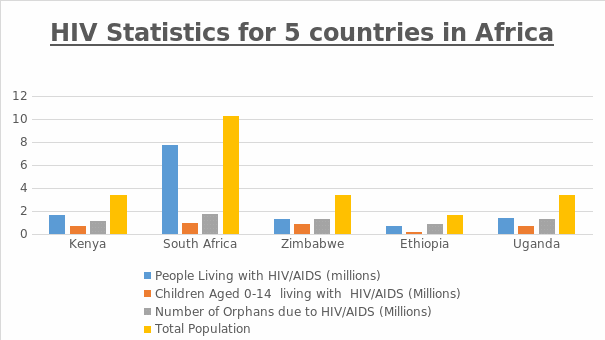Introduction
HIV/AIDS is a global public health concern that originated in Africa in the early 20th century. The deadly disease originated in central Africa from a chimpanzee, and it was known as the simian immunodeficiency virus (Odugbesan et al. 573). When hunters came into contact with the infected chimpanzee, the virus spread to humans. The virus infected human blood and caused an immunity deficiency known as Acquired Immunodeficiency Syndrome. The virus weakened people’s immunity making them vulnerable to opportunistic diseases such as tuberculosis.
Analysis
The severity and prevalence vary from one nation to another, depending on how the nation strategizes to manage the disease effectively. Although Africa is home to about 15% of the global population, it has the highest HIV prevalence compared to Asia, the largest continent on earth (Girum et al. 7). To understand the prevalence of the disease and the actions taken by the African nations, five countries were selected for analysis: Kenya, South Africa, Zimbabwe, Ethiopia, and Uganda. The investigation involved adults, children aged 0-14, orphans living with the virus, and the entire population affected. The results will determine the effectiveness of the governmental intervention.
The number of people living with HIV/AIDS in Kenya, South Africa, Zimbabwe, Ethiopia, and Uganda is 3.4, 10.3, 3.3, 1.6, and 3.7 million, respectively (Alene 34). South Africa has the highest number of cases because of poverty, inequality, and lack of quality education. In the Southern part of Africa, HIV/AIDS is not only a medical concern but also a social concern caused by social causes. In Kenya, Uganda, and Zimbabwe, the infection rate has been declining because of the deliberate moves by the governments to educate the people on the virus and the best way to control it (Alene 27). The number of people living with HIV in Zimbabwe has been rising due to instability and the economy’s collapse in 2008. However, the government has put in measures to contain the spread of the virus through civic education.
Ethiopia has the lowest prevalence of HIV due to the government’s effort to set up an HIV committee to ensure that prevention measures are practiced all over the country. The committee proposed the best control strategies through civic education. Further, the government capitalized on sharing of condoms in a bid to fight the disease in the country (Odugbesan et al. 573). Civic education, investment in condoms, and commercial distribution of HIV prevention promotion make it possible to lower the prevalence of the disease and increase people’s quality of life (Girum et al. 7). The chart presented on page one shows the prevalence of the disease in the selected African countries.
Conclusion
Half of the world’s poorest population in the world lives in Africa. Since poverty and unemployment are the risk factors facilitating the spread of HIV/AIDS, Africans are more susceptible to the disease. The selected cases represent parts of the nations, and the analysis can be extrapolated to represent the entire African continent. As the rate of the virus increases in other countries, it falls on the nations that have made a deliberate effort to fight the disease. South Africa has the highest number of cases, reflecting the people’s quality of life. The case of Ethiopia is a source of hope as it serves as a benchmark to lower the case of HIV. The method used by the Ethiopian government to eradicate the disease can be applied to other parts of Africa to reduce the prevalence and increase the quality of life.

Works Cited
Alene, Kefyalew Addis, et al. “Spatial patterns of tuberculosis and HIV co-infection in Ethiopia.” PloS one vol. 14, no.12, 2019. doi:10.1371/journal.pone.0226127
Girum, Tadele, Abebaw Wasie, and Abdulsemed Worku. “Trend of HIV/AIDS for the last 26 years and predicting achievement of the HIV prevention targets by 2020 in Ethiopia: a time series analysis.” BMC infectious diseases vol.18 no.1, 2018.
Odugbesan, Jamiu Adetola, and Husam Rjoub. “Evaluating HIV/Aids prevalence and sustainable development in sub-Saharan Africa: the role of health expenditure.” African Health Sciences vol.20 no.2, 2020, pp. 568-578. doi:10.4314/ahs.v20i2.4